Parkside PSSA 18 A1 User Manual [en, fr, de]

CORDLESS SABRE SAW PSSA 18 A1
CORDLESS SABRE SAW |
SCIE SABRE SANS FIL |
Translation of the original instructions |
Traduction des instructions d‘origine |
ACCUSABELZAAG |
AKKU-SÄBELSÄGE |
Vertaling van de originele gebruiksaanwijzing |
Originalbetriebsanleitung |
IAN 104447

Before reading, unfold the page containing the illustrations and familiarise yourself with all functions of the device.
Avant de lire le mode d‘emploi, ouvrez la page contenant les illustrations et familiarisez-vous ensuite avec toutes les fonctions de l‘appareil.
Vouw vóór het lezen de pagina met de afbeeldingen open en maak u vertrouwd met alle functies van het apparaat.
Klappen Sie vor dem Lesen die Seite mit den Abbildungen aus und machen Sie sich anschließend mit allen Funktionen des Gerätes vertraut.
GB / IE |
Translation of the original instructions |
Page |
4 |
FR / BE |
Traduction des instructions d‘origine |
Page |
21 |
NL / BE |
Vertaling van de originele gebruiksaanwijzing |
Pagina |
40 |
DE / AT / CH |
Originalbetriebsanleitung |
Seite |
59 |
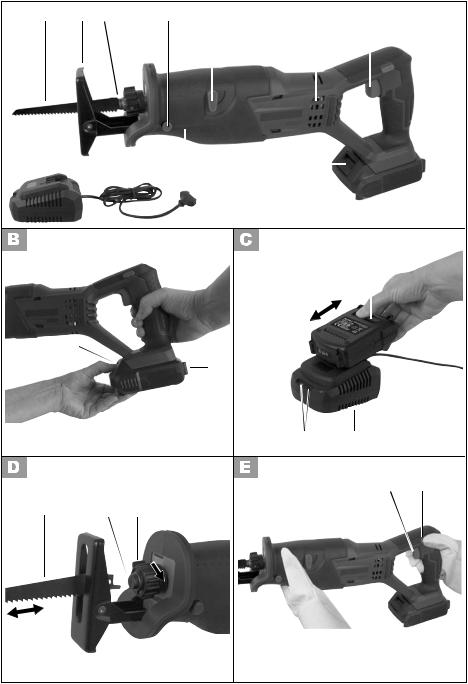
|
1 |
2 |
3 |
4 |
5 |
6 |
7 |
8 |
 9
9
 10
10
14
13 |
12 |
 11
11
12
11 
14a 14
8 9
1 |
3 |
4 |
11

GB IE |
|
Content |
|
Introduction ................................. |
4 |
Intended Use................................ |
4 |
General Description...................... |
5 |
Scope of delivery.............................. |
5 |
Overview......................................... |
5 |
Function Description .......................... |
5 |
Technical Data.............................. |
5 |
Notes on Safety ........................... |
6 |
Symbols........................................... |
6 |
General safety instructions for power |
|
tools ................................................ |
7 |
Special Safety Directions for the device 9 |
|
Correct handling of the battery charger. 11 |
|
Charging the battery.................. |
12 |
Removing/inserting the battery ......... |
12 |
Recharging the battery..................... |
12 |
Used batteries ................................ |
13 |
Assembly................................... |
13 |
Installing/changing the blade........... |
13 |
Operation .................................. |
13 |
Switching on and off ....................... |
14 |
Adjusting the base plate .................. |
14 |
Switching on/off the oscillating function 14 |
|
Checking the charge status of the re- |
|
chargeable battery.......................... |
14 |
Practical tips................................... |
15 |
Cleaning/Maintenance ............... |
16 |
Cleaning........................................ |
16 |
General maintenance ...................... |
16 |
Storage...................................... |
16 |
Waste Disposal/ |
|
Environmental Protection ........... |
16 |
Guarantee ................................. |
17 |
Repair Service............................ |
18 |
Service-Center............................ |
18 |
Importer .................................... |
18 |
Spare Parts/Accessories ............. |
19 |
Trouble Shooting........................ |
20 |
Translation of the original EC |
|
declaration of conformity ........... |
78 |
Exploded Diagram ..................... |
81 |
4
Introduction
Congratulations on the purchase of your new device. With it, you have chosen a high quality product. During production, this equipment has been checked for quality and subjected to a final inspection. The functionality of your equipment is therefore guaranteed.
The operating instructions constitute  part of this product. They contain
part of this product. They contain
important information on safety, use and disposal.
Before using the product, familiarise yourself with all of the operating and safety instructions. Use the product only as described and for the applications specified. Keep this manual safely and in the event that the product is passed on, hand over all documents to the third party.
Intended Use
The device is suitable for light and medium sawing through wood, plastic and plasterboard. If a separately available saw blade is used, it is also possible to saw through metal. The device is not suitable for commercial use.
Any other use that is not explicitly approved in these instructions may result in damage to the equipment and represent a serious danger to the user.
The operator or user is responsible for accidents or damage to other people or their property. The manufacturer is not liable for damages caused by unspecified use or incorrect operation.

General Description
The illustration of the principal functioning parts can be found on the front and back foldout pages.
Scope of delivery
Carefully unpack the trimmer and check that it is complete. Dispose of the packaging material correctly.
-Cordless reciprocating saw
-Saw blade
-Rechargeable battery
-Charger
-Instruction Manual
Overview
1Saw blade
2Footplate
3Saw blade retainer
4Chuck ring
5Adjustment button for the base plate
6Rotary switch for oscillating movement
7Ventilation slit
8On/off switch
9Switch lock
10Rear handle
11Rechargeable battery
12Unlock button - rechargeable battery
13Front handle
14Charger
GB IE
Function Description
The cordless sabre saw is a hand-held pendulum jigsaw with a saw blade that moves back and forth. The oscillating motion can be switched on to improve the progress of the sawing action.
Read the sections below to learn more about each operating element’s function.
Technical Data
Appliance |
|
|
|
Motor voltage............................. |
|
|
18 V |
Idling speed n ............ |
|
0-3000 min-1 (rpm) |
|
0 |
|
|
IPX0 |
Protection category |
........................... |
|
|
Stroke.............................. |
|
approx. 20 mm |
|
Max. cutting depth |
|
|
|
Wood.................................... |
|
|
100 mm |
Metal ........................................ |
|
|
8 mm |
Weight (incl. accessories) ............... |
2.5 kg |
||
Sound pressure level |
|
|
|
(LPA) .................. |
85.73 dB (A), KPA=3 dB |
||
Sound power level |
|
|
|
(LWA) ................ |
96.73 dB(A); KWA=3 dB |
||
Vibration (ah).......................................... |
|
|
13.88 m/s2 |
Sawing boards .................. |
|
|
|
Sawing wood beams.......... |
|
17.01 m/s2 |
|
|
|
|
K=1,5 m/s2 |
Battery (Li-Ion) .................... |
|
PAP 18-1.5 A1 |
|
Number of battery cells......................... |
|
5 |
|
Nominal voltage ........................ |
|
|
18 V |
Capacity..................................... |
|
|
1.5 Ah |
Charging time ...................... |
|
|
approx. 1 h |
Recharger ............................. |
|
|
JLH-H150-18 |
Nominal consumption.................... |
|
40 W |
|
Voltage input ......... |
100-240 V~, 50-60 Hz |
||
Voltage output .............. |
|
18 V |
1500 mA |
Protection class ................................. |
|
|
II |
Protection category |
........................... |
|
IPX0 |
5

GB IE
Noise and vibration values have been determined according to the standards and regulations mentioned in the declaration of conformity.
Technical and optical changes may be undertaken in the course of further development without notice. All dimensions, references and information in this instruction manual are therefore not guaranteed. Legal claims made on the basis of the instruction manual can therefore not be considered as valid.
The stated vibration emission value was measured in accordance with a standard testing procedure and may be used to compare one power tool to another.
The stated vibration emission value may also be used for a preliminary exposure assessment.
Warning:
The vibration emission value may differ during actual use of the power tool from the stated value depending on the manner in which the power tool is used.
Safety precautions aimed at protecting the user should be based on estimated exposure under actual usage conditions (all parts of the operating cycle are to be considered, including, for example, times during which the power tool is turned off and times when the tool is turned on but is running idle).
Notes on Safety
This section details the basic safety instructions for working with the appliance.
Symbols
Symbols on the Equipment
Caution!
Read through the instruction manual carefully.
Wear eye protection.
Wear ear protection.
Wear breathing protection.
Wear cut-resistant gloves.
Keep other people away from the device.
Keep hands away from the sawing area.
Remove the battery from the device before carrying out any work.
Electrical appliances must not be disposed of with the domestic waste.
Symbols on the battery
Do not dispose of batteries in household waste, fire or water.
6

Do not subject the battery to strong sunlight over long periods and
do not leave it on a heater (max. 45°C).
 Take batteries to an old battery collection point where they will be recycled in an environmentally friendly manner.
Take batteries to an old battery collection point where they will be recycled in an environmentally friendly manner.
Symbols on the recharger
Caution!
Read the operating instructions before charging.
The recharger is for indoor use only.
T2A
Miniature fuse
Protection class II
Electrical appliances must not be disposed of with the domestic waste.
LED display while charging.
Symbols in the manual
Warning symbols with information on damage and injury prevention.
Instruction symbols (the instruction is explained at the place of the exclamation mark) with information on preventing damage.
Help symbols with information on improving tool handling.
GB IE
General safety instructions for power tools
WARNING! Read all safety directions and instructions.
Omissions in the compliance with safety directions and instructions can cause electrical shock, fire and/or severe injuries.
Retain all safety directions and instructions for future use.
The term „power tool“ in the warnings refers to your mains-operated (corded) power tool or battery-operated (cordless) power tool.
1) WORK AREA SAFETY
•Keep work area clean and well lit. Cluttered or dark areas invite accidents.
•Do not operate power tools in explosive atmospheres, such as in the presence of flammable
Iiquids, gases or dust. Power tools create sparks which may ignite the dust or fumes.
•Keep children and bystanders away while operating a power tool. Distractions can cause you to lose control.
2) ELECTRICAL SAFETY
•Power tool plugs must match the outlet. Never modify the plug in any way. Do not use any adapter plugs with earthed (grounded) power tools. Unmodified plugs and matching outlets will reduce risk of electric shock.
•Avoid body contact with earthed or grounded surfaces, such as pipes, radiators, ranges and re-
7

GB IE
frigerators. There is an increased risk of electric shock if your body is earthed or grounded.
•Do not expose power tools to rain or wet conditions. Water entering a power tool will increase the risk of electric shock.
•Do not abuse the cord. Never use the cord for carrying, pulling or unplugging the power tool. Keep cord away from heat, oil, sharp edges or moving parts. Damaged or entangled cords increase the risk of electric shock.
•When operating a power tool outdoors, use an extension cord suitable for outdoor use. Use of a cord suitable for outdoor use reduces the risk of electric shock.
•If operating a power tool in a damp location is unavoidable, use a residual current device (RCD) protected supply. Use of an RCD reduces the risk of electric shock.
3) PERSONAL SAFETY
•Stay alert, watch what you are doing and use common sense when operating a power tool. Do not use a power tool while you are tired or under the influence of drugs, alcohol or medication. A moment of inattention white operating power tools may result in serious personal injury.
•Use personal protective equipment. Always wear eye protection. Protective equipment such as dust mask, non-skid safety shoes, hard hat, or hearing protection used for appropriate conditions will reduce personal injuries.
•Prevent unintentional starting.
Ensure the switch is in the off-po-
8
sition before connecting to power source and/or battery pack, picking up or carrying the tool.
Carrying power tools with your finger on the switch or energising power tools that have the switch on invites accidents.
•Remove any adjusting key or wrench before turning the power tool on. A wrench or a key left attached to a rotating part of the power tool may result in personal injury.
•Do not overreach. Keep proper footing and balance at all times.
This enables better control of the power tool in unexpected situations.
•Dress properly. Do not wear loose clothing or jewellery. Keep your hair, clothing and gloves away from moving parts. Loose clothes, jewellery or long hair can be caught in moving parts.
•If devices are provided for the connection of dust extraction and collection facilities, ensure these are connected and properly used. Use of dust collection can reduce dust-related hazards.
4) POWER TOOL USE AND CARE
•Do not force the power tool. Use the correct power tool for your application. The correct power tool will do the job better and safer at the rate for which it was designed.
•Do not use the power tool if the switch does not turn it on and off. Any power tool that cannot be controlled with the switch is dangerous and must be repaired.
•Disconnect the plug from the power source and/or the battery pack from the power tool before making any adjust

-ments, changing accessories, or storing power tools. Such preven-
tive safety measures reduce the risk of starting the power tool accidentaIly.
•Store idle power tools out of the reach of children and do not allow persons unfamiliar with the power tool or these instructions to operate the power tool. Power tools are dangerous in the hands of untrained users.
•Maintain power tools. Check for misalignment or binding of moving parts, breakage of parts and any other condition that may affect the power tool’s operation. If damaged, have the power tool repaired before use. Many accidents are caused by poorly maintained power tools.
•Keep cutting tools sharp and clean. Properly maintained cutting tools with sharp cutting edges are less Iikely to bind and are easier to control.
•Use the power tool, accessories and tool bits etc. in accordance with these instructions, taking into account the working conditions and the work to be performed. Use of the power tool for
operations different from those intended could result in a hazardous situation.
5)CAREFUL HANDLING AND USE OF BATTERY DEVICES
•Charge the batteries only in chargers that are recommended by the manufacturer. Risk of fire if a charger that is suitable for a specific type of battery is used with other batteries.
•In the power tools, use only the batteries designed for the purpose. The use of other batteries may result in injuries and risk of fire.
GB IE
•Keep the unused battery away from paper clips, coins, keys, nails, screws and other small metal objects, which could cause bridging of the contacts. A short circuit between the battery contacts may cause burns or fire.
•If used incorrectly, liquid may leak from the battery. Avoid contact with this. In the event of accidental contact, rinse off with water. If the liquid gets into eyes, seek medical assistance. Leaking battery fluid may cause skin irritations or burns.
6) SERVICE
•Have your power tool serviced by a qualified repair person using only identical replacement parts. This will ensure that the safety of the power tool is maintained.
Special Safety Directions for the device
1)SPECIAL SAFETY INSTRUCTIONS FOR RECIPROCATING SAWS
•Hold the electric tool by the insulated gripping surfaces when performing work in which the cutting tool may come into contact with hidden wiring. Contact with a live wire can also cause a charge in metal parts of the device and result in an electric shock.
•Keep hands away from the sawing area. Do not reach underneath the work piece. Upon contact with the blade there is a risk of injury.
•Only when the electric tool is turned on should the sawing blade be moved against the
9

GB IE
work piece. There is a risk of kickback if the tool insert jams in the work piece.
•Make sure that the base plate is securely placed against the work piece during sawing. The saw blade can tilt and lead to loss of control over the power tool.
•After you have finished work, turn the power tool off and do not pull the saw blade out of the cut until it has come to a standstill. In this way you will avoid any kickback and can safely put down the power tool.
•Use only undamaged saw blades in perfect condition. Bent or blunt blades can break, adversely affect the cut or cause kickback.
•Do not brake the saw blade after switching the device off by applying side pressure. The saw blade may be damaged, break or cause a kickback.
•Tighten the material firmly. Do not support the work piece by hand or foot. Do not touch any objects or the ground with the saw running. There is a risk of kickback.
•Use suitable detectors in order to find hidden supply lines or ask the local utility company.
Contact with electrical cables can lead to electric shock and fire, contact with a gas pipe can result in an explosion. Damage to a water pipe can lead to property damaged and electric shock.
•Hold the power tool tightly with both hands while working and ensure a secure footing. The power tool is guided more securely with both hands.
•Secure the work piece. A work piece that is retained with clamping devices or a vice is held more securely
10
than with your hand.
•Wait until the power tool has stopped before placing it down.
The tool insert can tilt and lead to loss of control over the power tool.
•Do not saw any materials (e.g. lead-based paints and coatings or materials containing asbestos) whose dust can be harmful.
2)SPECIAL SAFETY DIRECTIONS FOR BATTERY-OPERATED TOOLS
•Ensure that the device is switched off before inserting the battery. Inserting a battery into a power tool that is switched on may result in accidents.
•Recharge the batteries indoors only because the battery charger is designed for indoor use only. Risk of electric shock.
•To reduce the electric shock hazard, unplug the battery charger from the mains before cleaning the charger.
•Do not subject the battery to strong sunlight over long periods and do not leave it on a heater. Heat damages the battery and there is a risk of explosion.
•Allow a hot battery to cool before charging.
•Do not open up the battery and avoid mechanical damage to the battery. Risk of short circuit and fumes may be emitted that irritate the respiratory tract. Ensure fresh air and seek medical assistance in the event of discomfort.
•Do not use non-rechargeable batteries. This could damage the appliance.

3) RESIDUAL RISKS
Even if properly operating and handling this electric tool, some residual risks will remain. Due to its construction and build, this electric tool may present the following hazards:
a)Lung damage, if suitable respiratory protection is not worn;
b)Cuts
c)Ear damage if working without ear protection.
d)Damage to your health caused by swinging your hands and arms when operating the appliance for longer periods of time or if the unit is not held or maintained properly.
Warning! During operation, this electric tool generates an electromagnetic field which, under certain circumstances, may impair the functionality of active or passive medical implants. To reduce the risk of serious or lethal injuries, we recommend that persons with medical implants consult their doctor and the manufacturer of their medical implant before operating the machine.
Correct handling of the battery charger
•This device can be used by individuals with reduced physical, sensory or mental capabilities or a lack of experience or knowledge if they are supervised or have been instructed in how to use the device safely and understand the associated dangers. Children must not play with the device.
GB IE
•To charge the battery, use only the charger supplied. Risk of fire and explosion. This ensures that the safety of the device is maintained.
•Before each use, check the charger, cable and plug and have them repaired by qualified professionals and only with original parts. Do not use a defective charger and do not open it up yourself. This ensures that the safety of the device is maintained.
•Connect the charger only to a socket with an earth. Ensure that the mains voltage matches the specifications on the charger rating plate. Risk of electric shock.
•Disconnect the charger from the mains before closing or opening connection to the battery / power tool / device. This ensures that the battery and charger are not damaged.
•Keep the charger clean and away from wet and rain. Do not use the charger outdoors. Dirt and the entry of water increase the risk of electric shock.
•Operate the charger only with the appropriate original batteries. Charging other batteries may result in injuries and risk of fire.
•Avoid mechanical damage to the charger. This can result in internal short circuits.
•Do not operate the charger on a combustible surface (e.g. paper, textiles). Risk of fire due to heating during charging.
•If the power cable for this equipment is damaged, it must be replaced by the manufacturer, a customer service agent of the same or a similarly qualified person in order to prevent
11

GB IE
hazards.
•Do not charge non-rechargeable batteries in the charger. This could damage the appliance.
Charging the battery
Do not expose the battery to extreme conditions such as heat or impact. Risk of injury from escaping electrolytic solution! After eye/skin contact, rinse the affected areas with water or a neutraliser and consult a doctor.
Charge the battery in a dry room only. Prior to attaching the charger, check that the battery’s outer surface is clean and dry. There is a risk of injury due to electric shock.
Only use the charger from the package to charge the battery. Mind not to charge the appliance for more than 1 hour at a time. If you do, the battery and the appliance may be damaged and longer charging times would be a waste of energy. Excessive charging will void the warranty.
•Charge the battery before the first time of use. Do not briefly charge the battery several time in a row.
•If a fully recharged battery lasts for considerably shorter operating times, the battery is used up and needs to be replaced. Only use an OEM spare battery available from our Customer Service.
•Always take heed of the applicable safety instructions as well as the environmental protection regulations and information.
12
•The warranty excludes all defects caused by improper handling.
Removing/inserting the battery
1.To remove the battery (11) from the appliance, press the release button (12) on the battery and pull out the battery.
2.To insert the battery (11), place it on the guide track and push it back into the appliance. It will audibly snap in.
Recharging the battery
Charge the battery (11) when only the red LED of the charge indicator
(11a) is lit (see “Checking the battery charge status”).
1.Remove the battery (11) from the appliance, as necessary.
2.Slide the rechargeable battery (11) onto the charger (14). It locks into place audibly.
3.Plug the battery charger (14) into a mains outlet.
4.When the battery is fully recharged unplug the battery charger (14) from the mains.
5.Press the release button ( 10) on the battery (11) and pull the battery out of the battery charger (14).
10) on the battery (11) and pull the battery out of the battery charger (14).
Overview of the LED indicators (14a) on the charger (14):
green LED flashes:
Charger is connected to the mains without a battery. red LED lights up: Charging.

green LED lights up: Charging is completed. green LED flashes:
The battery voltage is < 12.5 V, battery is pre-charged for
30 min.
LEDs flash red and green:
Defective battery installed, no charging.
LEDs light up in red and green: Rechargeable battery is too cold or too hot.
After a cooling or heating period, charging starts automatically.
Used batteries
•If a fully recharged battery lasts for considerably shorter operating times, the battery is used up and needs to be replaced. Only use an OEM battery pack replacement available from our Customer Service.
•Always take heed of the applicable safety instructions as well as the environmental protection regulations and information (see “Waste Disposal and
Environmental Protection”).
Assembly
Only insert the rechargeable battery when the device is completely assembled. If the device is switched on accidentally, there is a danger of injury.
Installing/changing the blade
Always wear protective gloves when handling the saw blade in order to avoid cutting yourself.
GB IE
Caution, risk of Injury!
-Do not use any blunt or bent blades or blades which are damaged in any other way.
-Always insert a suitable saw blade.
An overview of appropriate blades can be found in “Spare Parts/Accessories”.
Installing the blade:
1.Turn the chuck ring (4) in the
direction of the arrow  and insert the shank of the saw blade
and insert the shank of the saw blade
(1)all the way into the slot of the saw blade holder (3).
2.To lock, turn the chuck ring (4) back to the starting position.
3.Check that the saw blade is secure by pulling on it.
Removing the saw blade:
4.Turn the chuck ring (4) in the
direction of the arrow  and pull the blade out of the saw blade holder.
and pull the blade out of the saw blade holder.
For certain work, the saw blade can also be inserted after turning through 180°.
Operation
When working with the device, always wear suitable clothing and appropriate protective equipment.
Prior to each use it must be ensured that the device is working correctly.
Personal protective equipment and a fully functional device reduce the risk of inju-
13

GB IE
ries and accidents.
After the device has been switched off, the blade continues moving for some time. Do not touch the moving blade and do not attempt to brake it. Danger of injury!
Switching on and off
Ensure your stance is stable and hold the device tightly with both hands and away from your body. Before switching the device on, ensure it is not in contact with the work piece.
Switching on:
1.Ensure that the battery (11) is inserted (see “Removing/inserting the battery”).
2.Press the switch lock (9) and the on/off switch (8), then release the switch lock (9).
3.By using the on/off switch (8) you can progressively control the stroke rate.
Gentle pressure: low stroke rate. Greater pressure: higher stroke rate.
The on/off switch cannot be locked.
Switching off:
4.Release the on/off switch (8).
Adjusting the base plate
To adapt to the work piece, the base plate can be adjusted and swivelled to 4 positions.
1.Press the adjusting button (5).
2.The base plate (2) can now be ad-
14
justed to the desired position. It can now be felt locking into place.
3.The base plate (2) can be pivoted by applying light pressure.
Switching on/off the oscillating function
To improve the progress of the sawing process, an oscillating motion can be switched on.
Sawing without oscillation:
-For thin, hard work pieces such as wooden boards.
-In order to achieve cleaner cut edges.
Sawing with oscillation:
-For processing work pieces with medium and soft strength, such as soft and hard wood, tree wood, insulation material.
Switching on the oscillating function:
1.Turn the rotary switch (6) to posi-
tion “1”.
Switching off the oscillating function:
2.Turn the rotary switch (6) to position “0”.
Checking the charge status of the rechargeable battery
The state of charge display (11a) indicates the state of charge of the battery (11).
Press the button (11b) on the battery (11). The state of charge of the battery is displayed by illuminating the 3-colour LED lights of
the state of charge display (11a). All LEDs are on: Battery is fully
charged.
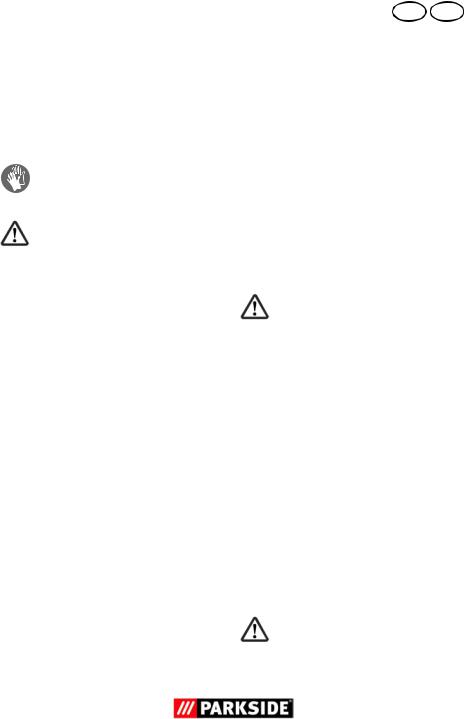
GB IE
Red and yellow LEDs are on:
Battery has a residual charge
(< 90 %).
Red LED lights up: Battery is empty, please charge.
Practical tips
Wear gloves when handling the saw blade. In this way, you avoid injury from cuts.
Caution: Risk of injury and damage to property!
-Do not use any blunt or bent blades or blades which are damaged in any other way.
-Before sawing the work piece, check for hidden foreign objects such as nails, screws. These must be removed.
-Always insert a suitable saw blade.
-Secure the work piece with the aid of clamping devices on the workbench.
-Apply only as much pressure as is required for sawing. If there is excessive pressure, the sawing blade may bend and break.
-Switch the device off immediately if the sawing blade jams. Spread the saw cut out and pull the blade out carefully.
-Always stand to the side of the saw when working.
the device on, ensure it is not in contact with the work piece.
2.Place the base plate on the work piece.
3.Cut with a uniform forward motion. You
can saw horizontally (see  ), diagonally or vertically (see
), diagonally or vertically (see  ).
).
4.After completion of the work, first remove the blade from the saw cut and then switch the device off.
 Plunge sawing:
Plunge sawing:
Plunge cuts are technically more demanding and harbour a greater risk. Only perform this work if you are familiar with this technique.
Plunge cuts may only be carried out in soft materials such as wood or plasterboard and with short blades (max. length 150 mm). There is a risk of kickback and personal injury.
1.Place the front edge of the base plate (2) on the work piece so that the saw blade
(1)does not touch the work piece.
2.Turn the device on and let the saw blade
(1)slowly plunge into the work piece.
3.When the work piece depth has been cut through, continue sawing as usual.
Flush separation:
With elastic bi-metal saw blades (see
-Always make sure that the workspare parts/accessories) you can separate place is well ventilated. water pipes, for example, flush to the wall.
-Avoid over-stressing the device
while working.

 Conventional sawing:
Conventional sawing:
1. Turn the device on. Before switching
Make sure that the blade is always longer than the pipe diameter. There is a risk of kickback and personal injury.
15
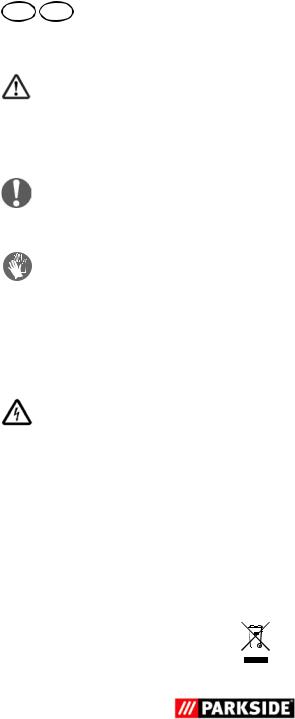
GB IE
Cleaning/Maintenance
Remove the battery from the device before carrying out any work or transporting it.
If the device is switched on accidentally, there is a danger of injury.
Repair and servicing work not described in this manual should always be carried by our Service Centre. Use only original parts.
Always wear protective gloves when handling the saw blade in order to avoid cutting yourself.
The following cleaning and servicing should be done regularly. This will ensure a long and reliable service life.
Cleaning
Do not spray the appliance with water and do not immerse it in water. Electric shock hazard!
•Keep clean the ventilation slots, motor housing and handles of the appliance. Use a damp cloth or a brush.
Do not use cleaning agents or solvents. You may otherwise irreparably damage the appliance.
•Clean the saw blade holder with a brush or by blowing out with compressed air. To do this, remove the saw blade from the device.
General maintenance
•Prior to every use, check the appliance for obvious defects such as loose, worn
16
or damaged parts.
•Check covers and safety devices for damages and correct installation. Replace as necessary.
•Replace a blunt or bent blade or one which has been damaged in some other way.
Storage
•Store the device in a dry place well out of reach of children.
•Remove the battery before storing the unit for longer periods of time (e.g. hibernation).
•Store the battery only in a partially charged state. The state of charge should be 40 – 60 % over a longer storage period (two LED lights of the charge status indicator ( 11a) light up).
11a) light up).
•During a longer storage period, check the state of charge of the battery and recharge if necessary roughly every
3 months.
•In order to keep the battery well charged, avoid exposing the appliance to extreme heat or cold in storage.
•Store the equipment between 10° C and 25° C. During storage, avoid extreme cold or heat so the battery does not lose power.
Waste Disposal/ Environmental Protection
Remove the battery from the device and take the device, battery, accessories and packaging for environmentally friendly recycling.
Machines do not belong with domestic waste.

Do not dispose of batteries in household waste, fire (risk of explosion) or water. Damaged batteries may damage the environment and your health if toxic fumes or liquids leak out.
•Return the unit to a recycling centre.
•Dispose of batteries in discharged condition. We recommend covering the pole with adhesive tape to prevent a short circuit. Do not open up the battery.
•Dispose of batteries in accordance with the local regulations. Take batteries to an old battery collection point where they will be recycled in an environmentally friendly manner. For information about this, ask your local waste management company or our service centre.
•Throw the cut grass on the compost. Do not throw it in the normal household waste.
Guarantee
Dear Customer,
This equipment is provided with a 3-year guarantee from the date of purchase.
In case of defects, you have statutory rights against the seller of the product. These statutory rights are not restricted by our guarantee presented below.
Terms of Guarantee
The term of the guarantee begins on the date of purchase. Please retain the original receipt. This document is required as proof of purchase.
If a material or manufacturing defect occurs within three years of the date of purchase of this product, we will repair or replace – at our choice – the product for you free of charge. This guarantee requires the defective equipment and proof of purchase to be presented within the three-year period with
GB IE
a brief written description of what constitutes the defect and when it occurred.
If the defect is covered by our guarantee, you will receive either the repaired product or a new product. No new guarantee period begins on repair or replacement of the product.
Guarantee Period and Statutory Claims for Defects
The guarantee period is not extended by the guarantee service. This also applies for replaced or repaired parts. Any damages and defects already present at the time of purchase must be reported immediately after unpacking. Repairs arising after expiry of the guarantee period are chargeable.
Guarantee Cover
The equipment has been carefully produced in accordance with strict quality guidelines and conscientiously checked prior to delivery.
The guarantee applies for all material and manufacturing defects. This guarantee does not extend to cover product parts that are subject to normal wear and may therefore be considered as wearing parts (e.g. saw blade, battery) or to cover damage to breakable parts (e.g. switches).
This guarantee shall be invalid if the product has been damaged, used incorrectly or not maintained. Precise adherence to all of the instructions specified in the operating manual is required for proper use of the product. Intended uses and actions against which the operating manual advises or warns must be categorically avoided.
The product is designed only for private and not commercial use. The guarantee will be invalidated in case of misuse or improper handling, use of force, or interventions not undertaken by our authorised service branch.
17

GB IE
Processing in Case of Guarantee
To ensure quick handling of you issue, please follow the following directions:
•Please have the receipt and identification number (IAN 104447) ready as proof of purchase for all enquiries.
•Please find the item number on the rating plate.
•Should functional errors or other defects occur, please initially contact the
service department specified below by telephone or by e-mail. You will then receive further information on the processing of your complaint.
•After consultation with our customer service, a product recorded as defective can be sent postage paid to the service address communicated to you, with the proof of purchase (receipt) and specification of what constitutes the defect and when it occurred. In order to avoid acceptance problems and additional costs, please be sure to use only the address communicated to you. Ensure that the consignment is not sent carriage forward or by bulky goods, express or other special freight. Please send the equipment inc. all accessories supplied at the time of purchase and ensure adequate, safe transport packaging.
Repair Service
For a charge, repairs not covered by the guarantee can be carried out by our ser-
vice branch, which will be happy to issue a cost estimate for you. We can handle only equipment that has been sent with ad-
equate packaging and postage. Attention: Please send your equipment to
our service branch in clean condition and with an indication of the defect. Equipment sent carriage forward or by bulky goods, express or other special
18
freight will not be accepted.
We will dispose of your defective devices free of charge when you send them to us.
Service-Center
GB Service Great Britain
Tel.: 0871 5000 720
(£ 0.10/Min.)
E-Mail: grizzly@lidl.co.uk
IAN 104447
IE |
Service Ireland |
|
Tel.: 1890 930 034 |
||
|
(0,08 |
EUR/Min., (peak)) |
|
(0,06 |
EUR/Min., (off peak)) |
E-Mail: grizzly@lidl.ie
IAN 104447
Importer
Please note that the following address is not a service address. Please initially contact the service centre specified above.
Grizzly Tools GmbH & Co. KG
Stockstädter Straße 20
63762 Großostheim, Germany www.grizzly-service.eu

GB IE
Spare Parts/Accessories
Spare parts and accessories can be obtained at www.grizzly-service.eu
If you do not have internet access, please contact the Service Centre via telephone (see
“Service-Center” Page 18). Please have the order number mentioned below ready.
Position |
Position |
Description |
Use |
Order No. |
||
instruction |
exploded |
|
|
|
||
manual |
drawing |
|
|
|
||
|
|
1 |
19 |
Wood saw blade |
for wood, plastic, |
1380 0221 |
|
||||||
|
|
|
|
(HCS 150 mm/6 TPI*) |
plasterboard |
|
|
|
11 |
16 |
Battery 18 V, 1,5 Ah |
|
8000 1161 |
|
|
|||||
|
|
14 |
21 |
Charger EU, 1,5 Ah |
|
8000 1082 |
|
|
|||||
Optionally available:
Description
Metal saw blade
Battery 18 V, 2,6 Ah
Charger EU, 2,6 Ah
Use |
Order No. |
for metal sheets, |
1380 0222 |
profiles and tubes |
|
|
8000 1162 |
|
8000 1086 |
* HCS = High Carbon Steel, steel with high carbon content TPI = Teeth per inch
We recommend using the battery only with the battery charger supplied.
More blades with a universal shank are commercially available for any purpose.
19
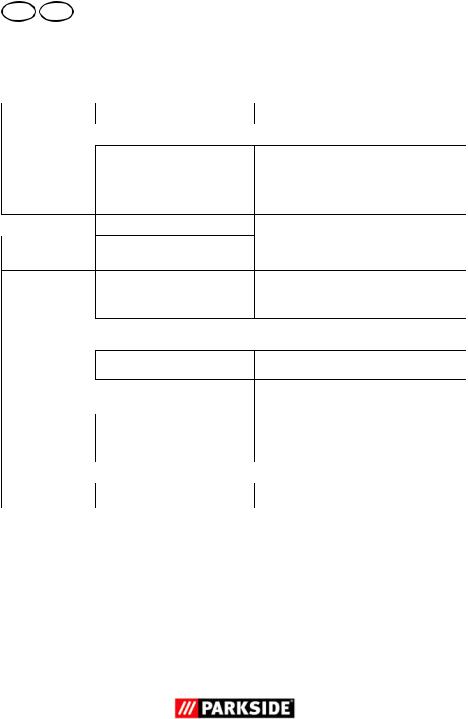
GB IE
Trouble Shooting
 Problem
Problem
Appliance won‘t start
 Intermittent operation
Intermittent operation
Poor sawing performance
Saw blade quickly becomes blunt
 Possible cause
Possible cause
Battery ( 11) discharged
11) discharged
 Battery (
Battery ( 11) not inserted
11) not inserted
Switch lock ( 11) has not been operated properly
11) has not been operated properly
 Corrective action
Corrective action
Recharge battery (see „Charging“)
 Insert battery (see „Operation“)
Insert battery (see „Operation“)
Switch on (see "Operation")
On/Off switch ( 7) defecSend in to Service Centre for repair tive
7) defecSend in to Service Centre for repair tive
Internal loose contact
On/Off switch ( 7) defec- Send in to Service Centre for repair tive
7) defec- Send in to Service Centre for repair tive
Saw blade unsuitable for the work piece to be worked on
 Saw blade blunt
Saw blade blunt
Incorrect sawing speed
 Low battery power
Low battery power
Saw blade unsuitable for the work piece to be worked on
 Too much pressure applied
Too much pressure applied
Sawing speed too high
Insert a suitable saw blade
 Insert a new saw blade
Insert a new saw blade
Adjust sawing speed
Charge battery ( 11) (see "Charging process")
11) (see "Charging process")
Insert a suitable saw blade (see "Installation")
 Reduce the pressure Reduce the sawing speed
Reduce the pressure Reduce the sawing speed
20

Sommaire |
|
Introduction ............................... |
21 |
Domaine d’utilisation ................. |
21 |
Description générale .................. |
22 |
Volume de la livraison .................... |
22 |
Vue synoptique .............................. |
22 |
Description du fonctionnement ......... |
22 |
Caractéristiques techniques ........ |
22 |
Instructions de sécurité............... |
23 |
Symboles et pictogrammes .............. |
23 |
Consignes de sécurité générales pour |
|
outils électriques ............................ |
24 |
Consignes de sécurité spéciales pour |
|
l’appareil ...................................... |
27 |
Maniement correct du chargeur d’accu 29 |
|
Opération de chargement .......... |
30 |
Retirer/utiliser l’accu....................... |
30 |
Charger l’accu............................... |
30 |
Accus usagés ................................ |
31 |
Montage .................................... |
31 |
Monter/changer la lame de scie...... |
31 |
Service....................................... |
32 |
Mise en marche et arrêt .................. |
32 |
Régler la plaque d’appui................. |
32 |
Activer/désactiver l’oscillation ......... |
32 |
Contrôlez l’état de la charge de la bat- |
|
terie ............................................. |
33 |
Indications de travail ...................... |
33 |
Nettoyage/Entretien................... |
34 |
Nettoyage..................................... |
34 |
Travaux généraux de maintenance ... |
35 |
Rangement ................................ |
35 |
Elimination/Protection de l’environ- |
|
nement ...................................... |
35 |
Pièces de rechange/Accessoires.. |
36 |
Dépannage ................................ |
37 |
Garantie .................................... |
38 |
Service Réparations ................... |
39 |
Service-Center............................ |
39 |
Importeur .................................. |
39 |
Traduction de la déclaration |
|
de conformité CE originale ......... |
78 |
Vue éclatée ................................ |
81 |
FR BE
Introduction
Toutes nos félicitations pour l’achat de votre nouvel appareil. Vous avez ainsi choisi un produit de qualité supérieure.
La qualité de l’appareil a été vérifiée pendant la production et il a été soumis à un contrôle final. Le fonctionnement de votre appareil est donc ainsi garanti.
La notice d’utilisation fait partie de ce produit. Elle contient des
instructions importantes pour la sécurité, l’utilisation et l’élimination des déchets. Avant d’utiliser ce produit, lisez attentivement les consignes d’emploi et de sécurité. N’utilisez le produit que tel que décrit et uniquement pour les domaines d’emploi indiqués. Conservez cette notice et remettez-la avec tous les documents si vous cédez le produit à un tiers.
Domaine d’utilisation
L’appareil est adapté pour des travaux de sciage légers et moyens dans le bois, le plastique et le placoplâtre. Le sciage du métal est possible en utilisant une lame de scie disponible séparément.
Cet appareil n’est pas adapté à une utilisation commerciale.
Toute autre utilisation qui n’est pas autorisée expressément dans ce mode d’emploi peut conduire à un endommagement de l’appareil et présenter un réel danger pour l’utilisateur.
L’opérateur ou l’utilisateur est responsable des accidents ou dommages survenant à d’autres personnes ou à leurs biens.
Le constructeur décline toute responsabilité en cas de dommages qui seraient occasionnés par une utilisation non conforme ou une manipulation inappropriée de l’appareil.
21

FR BE
Description générale
Vous trouverez les images correspondantes à l’arrière et à l’avant de ce document, sur la couverture.
Volume de la livraison
Déballez l’appareil et vérifiez que la livraison est complète. Evacuez le matériel d’emballage comme il se doit.
-Scie sabre sans fil
-Lame de scie
-Accumulateur
-Chargeur
-Notice d’utilisation
Vue synoptique
1Lame de scie
2Plaque d’appui
3Porte-lame
4Bague de serrage
5Bouton de réglage plaque d’appui
6Commutateur rotatif pour oscillation
7Fentes d’aération
8Interrupteur marche/arrêt
9Verrouillage d’enclenchement
10Poignée arrière
11Accumulateur (Batterie)
12Touche de déverrouillage batterie
13Poignée avant
14Chargeur
Description du fonctionnement
La scie sabre sans fil est une scie sauteuse pendulaire à guidage manuel, dotée d’une
22
lame de scie à mouvement de va-et-vient. Le mouvement pendulaire peut être activé pour améliorer la progression de la lame de scie.
Vous trouverez le fonctionnement des pièces de service dans les descriptions suivantes.
Caractéristiques techniques
Appareil |
|
Tension de moteur ...................... |
18 V |
Vitesse de rotation à vide n0 ..0-3000 min-1 |
||
Type de protection |
............................ |
IPX0 |
Course.................................. |
|
env. 20 mm |
Profondeur de coupe maxi. |
|
|
Bois ....................................... |
|
100 mm |
Métal ......................................... |
|
8 mm |
Poids (y compris accessoires)........... |
2,5 kg |
|
Niveau de pression acoustique |
|
|
(LPA) .................. |
85,73 dB (A); K PA =3 dB |
|
Niveau de puissance |
|
|
acoustique (LWA) .... |
96,73 dB(A); K WA =3 dB |
|
Vibration (a ) .......................................... |
|
|
Sciage deh planches ............ |
13,88 m/s2 |
|
Sciage de poutres ...en bois |
17,01 m/s2 |
|
|
|
K=1,5 m/s2 |
Accu (Li-Ion) ............. |
PAP 18 - 1.5 A1 |
|
Nombre de cellules ..............de batterie |
5 |
|
Tension nominale ........................ |
|
18 V |
Capacité...................................... |
|
1,5 Ah |
Temps de charge.......................... |
|
env. 1 h |
Chargeur .................... |
JLH - H150-18 |
|
Absorption nominale ...................... |
40 W |
|
Tension d’entrée/ |
|
|
input.................... |
100 - 240 V~, 50 - 60 Hz |
|
Tension de sortie/ |
|
|
output ......................... |
18 V |
1500 mA |
Classe de protection......................... |
II |
|
Type de protection............................ |
|
IPX0 |
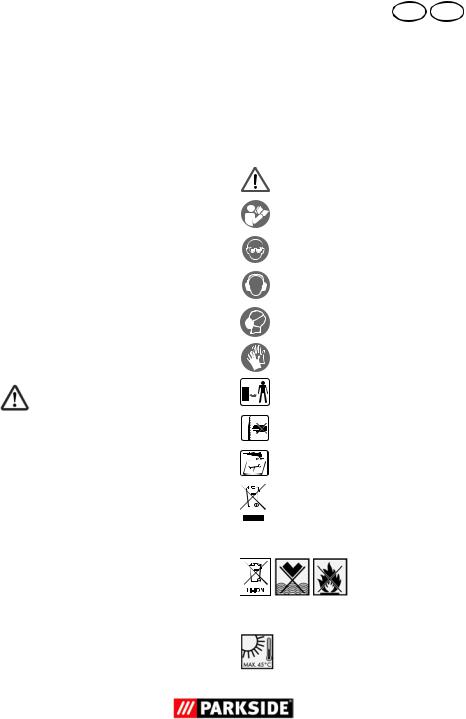
Les valeurs de bruit et de vibrations ont été définies conformément aux normes et prescriptions stipulées dans la déclaration de conformité. Des modifications techniques et optiques en vue d’un perfectionnement sont possibles sans notification préalable.
C’est pourquoi toutes les dimensions, informations, remarques et déclarations mentionnées dans ce manuel sont sans engagement de notre part. Par conséquent, des prétentions à des revendications juridiques qui se basent sur le manuel d’instructions d’emploi seront sans effet.
La valeur d’émission d’oscillation donnée a été mesurée d’après une procédure d’essai aux normes et peut être utilisée pour comparer un outil électrique avec un autre outil. L’indication du fait que la valeur totale de vibrations déclarée peut également être utilisée pour une évaluation préliminaire de l’exposition.
Avertissement :
La valeur d’émission d’oscillation peut, pendant l’utilisation réelle de l’outil électrique, différer de la valeur d’indication, selon la manière dont l’outil électrique est utilisé.
Il est nécessaire de fixer des mesures de sécurité pour la protection de l’opérateur qui sont fondées sur une estimation du déchargement pendant les conditions réelles d’utilisation (de ce fait, toutes les parties du cycle de fonctionnement sont à prendre en considération, par exemple, les durées pendant lesquelles l’outil électrique est mis hors circuit et les durées pendant lesquelles il est, certes allumé, mais ne subit aucune charge).
FR BE
Instructions de sécurité
Cette section traite des principales normes de sécurité lors du travail avec l’appareil.
Symboles et pictogrammes
Symboles apposés sur l’appareil
Attention!
Lisez attentivement les instructions d’emploi.
Portez une protection pour les yeux.
Portez une protection pour les oreilles.
Portez un équipement de protection respiratoire.
Porter des gants de protection.
Tenez les personnes éloignées de l‘appareil.
Éloignez vos mains des parties de sciage.
Avant tous travaux, retirez la batterie de l‘appareil.
Les outils électriques n’ont pas leur place dans les ordures ménagères.
Symboles sur l’accumulateur
Ne jetez pas l’accumulateur dans les ordures ménagères, le feu ou l’eau.
Ne laissez pas l‘accumulateur exposé pendant une longue durée aux rayons du soleil et ne posez pas celui-ci sur un radiateur (max. 45°C).
23

FR BE
Déposez les accumulateurs dans une déchèterie récupérant les anciennes batteries et où ceux-ci seront livrés à un centre de recyclage écologique.
Symboles sur le chargeur
Attention!
Lisez la notice d‘utilisation avant tout chargement.
Le chargeur n’est apte qu’à une utilisation en intérieurs.
T2A
Sécurité de l‘appareil
Classe de protection II
Les appareils n’ont pas leur place dans les ordures ménagères.
Affichage LED durant le chargement.
Symboles utilisés dans le mode d’emploi
Symbole de danger et indications relatives à la prévention de dommages corporels ou matériels.
Symbole d’interdiction (l’interdiction est précisée à la place des guillemets) et indications relatives à la prévention de dommages.
Symboles de remarque et informations permettant une meilleure utilisation de l‘appareil.
24
Consignes de sécurité générales pour outils électriques
AVERTISSEMENT ! Lisez toutes les consignes de sécurité et les instructions. Des omissions lors de
l‘observation des consignes de sécurité et des instructions peuvent causer une décharge électrique, un incendie et / ou de graves blessures.
Conservez toutes les consignes de sécurité et les instructions pour les consulter ultérieurement. Le terme
«outil» dans les avertissements fait référence à votre outil électrique alimenté par le secteur (avec cordon d’alimentation) ou votre outil fonctionnant sur batterie (sans cordon d’alimentation).
1) SÉCURITÉ SUR LE LIEU DE TRAVAIL
•Conservez votre zone de travail propre et bien éclairée. Les zones de travail en désordre et non éclairées peuvent être à l‘origine d‘accidents.
•Avec l‘outil électrique, ne travaillez pas dans un environnement soumis à un risque d‘explosion et dans lequel se trouvent des poussières, des gaz et des liquides inflammables. Les outils électriques produisent des étincelles qui peuvent enflammer la poussière ou les vapeurs.
•Pendant l‘utilisation de l‘outil électrique, tenez à distance les enfants et les autres personnes. En cas de distractions, vous pouvez perdre le contrôle de l‘appareil.
2) SÉCURITÉ ÉLECTRIQUE
•La fiche de raccordement de l‘outil
électrique doit convenir à la prise

de courant. La fiche ne doit pas être modifiée de quelle manière que ce soit. N‘utilisez aucune prise d‘adaptateur conjointement avec des outils électriques ayant une mise à la terre de protection.
Les fiches inchangées et les prises de courant appropriées diminuent le risque de décharge électrique.
•Evitez le contact du corps avec les surfaces mises à la terre, telles que les tubes, les chauffages, les fours et les réfrigérateurs. Il existe un risque accru de décharge électrique, si votre corps est mis à la terre.
•Tenez les outils électriques à distance de la pluie ou de l‘humidité. La pénétration de l‘eau dans un outil électrique augmente le risque d’une décharge électrique.
•Ne pas maltraiter le cordon. Ne jamais utiliser le cordon pour porter, tirer ou débrancher l’outil.
Maintenir le cordon à l’écart de la chaleur, du lubrifiant, des arêtes ou des parties en mouvement.
Des cordons endommagés ou emmêlés augmentent le risque de choc électrique.
•Si vous travaillez avec un outil électrique en plein air, utilisez uniquement un câble de prolongation qui soit adapté pour l‘extérieur. L‘emploi d‘un câble de prolongation approprié pour le domaine extérieur diminue le risque d’une décharge électrique.
•Si l‘utilisation de l‘outil électrique ne peut pas être évitée dans un environnement humide, utilisez un commutateur de protection de courant de défaut avec un courant de déclenchement de 30 milliampères ou moins. L‘utilisation d‘un commutateur de protection de courant de
FR BE
défaut réduit le risque d’une décharge électrique.
3) SÉCURITÉ DES PERSONNES
•Soyez attentif, faites attention à ce que vous faites et utilisez raisonnablement l‘outil électrique pendant votre travail. N‘utilisez aucun outil électrique si vous êtes fatigué ou vous trouvez sous l‘influence de drogues, d‘alcool ou de médicaments. Un moment d‘inattention durant l‘utilisation de l‘outil électrique peut être la cause de graves blessures.
•Portez toujours un équipement de protection individuel et des lunettes protectrices. Le port d‘un équipement de protection individuel, comme un masque anti-poussières, des chaussures de sécurité anti-dérapantes, un casque de protection ou des protections auriculaires, en fonction du type et de l‘utilisation de l‘outil électrique, diminue le risque des blessures.
•Evitez une mise en service non prévue. Assurez-vous que l‘outil
électrique est éteint avant que vous ne le connectiez à l‘alimentation en courant et / ou à l‘accumulateur, le portiez ou le déplaciez. Si en portant l‘appareil électrique, votre doigt appuie sur le commutateur ou que l‘appareil se mette en marche lorsque vous le connectez, cela peut entraîner un accident.
•Retirez les outils de réglage ou la clé à écrous avant de mettre l‘outil électrique sous tension. Un outil ou une clé qui se trouve dans une partie mobile de l‘appareil peut être à l‘origine de blessures.
•Ne pas se précipiter. Assurez-
25

FR BE
vous d‘avoir une position stable et d‘être tout le temps en équilibre. Vous pourrez ainsi mieux contrô-
ler mieux l‘outil électrique dans des situations inattendues.
•Portez des vêtements appropriés convenables. Ne portez aucun habit large ou parure. Maintenez vos cheveux, habits et gants loin des parties mobiles. Les habits légers, les parures ou les longs cheveux peuvent être saisis par les parties mobiles.
•Si des dispositifs d‘aspiration et de collecte supplémentaires peuvent être montés, assurezvous que ceux-ci sont connectés
et utilisés correctement. L‘utilisation d‘un dispositif d‘aspiration peut diminuer les risques engendrés par la poussière.
4)UTILISATION ET ENTRETIEN DE L’OUTIL
•Ne forcez pas l‘appareil. Utilisez pour votre travail l‘outil électrique le mieux adapté. Avec un outil électrique approprié, vous travaillez mieux et avec davantage de sécurité dans le secteur de travail donné.
•N‘utilisez aucun outil électrique dont le commutateur est défectueux. Un outil électrique qui ne peut plus être allumé ou éteint est dangereux et doit être réparé.
•Retirez la fiche de la prise de courant et / ou retirez l‘accumulateur avant d‘entreprendre des réglages sur un appareil, échanger des accessoires ou mettre de côté l‘appareil. Cette mesure de précaution empêche un démarrage involontaire de l‘outil électrique.
•Conservez les outils électriques inutilisés hors de la portée des
26
enfants. Ne laissez pas des personnes qui ne connaissent pas l‘appareil ou n‘ont pas lu ces instructions utiliser l‘appareil. Les
outils électriques sont dangereux s‘ils sont utilisés par des personnes inexpérimentées.
•Observer la maintenance de l’outil. Contrôlez si les parties mobiles fonctionnent correctement et ne se coincent pas ; vérifiez l’appareil pour voir si des pièces sont rompues ou sont endommagées, perturbant ainsi le fonctionnement de l‘outil électrique. Faites réparer les pièces endommagées avant d‘utiliser l‘appareil. Beaucoup d‘accidents ont pour origine des outils électriques mal entretenus.
•Maintenez les outils coupants aiguisés et propres. Les outils tranchants bien entretenus ayant des bords de coupe aiguisés se coincent moins et s‘utilisent plus facilement.
•Utilisez l‘outil électrique, les accessoires, les outils, etc. conformément à ces instructions. Prenez également en compte les conditions de travail et l‘activité à réaliser. L‘utilisation des outils électriques pour des buts autres que ceux prévus peut mener à des situations dangereuses.
5)UTILISATION DES OUTILS FONCTIONNANT SUR BATTERIES ET PRECAUTIONS D’EMPLOI
•Charger les accumulateurs uniquement avec les chargeurs qui sont recommandés par le fabricant. Il y a un risque d‘incendie si un chargeur, approprié pour un type précis d‘accumulateur, est utilisé avec d‘autres accumulateurs.
